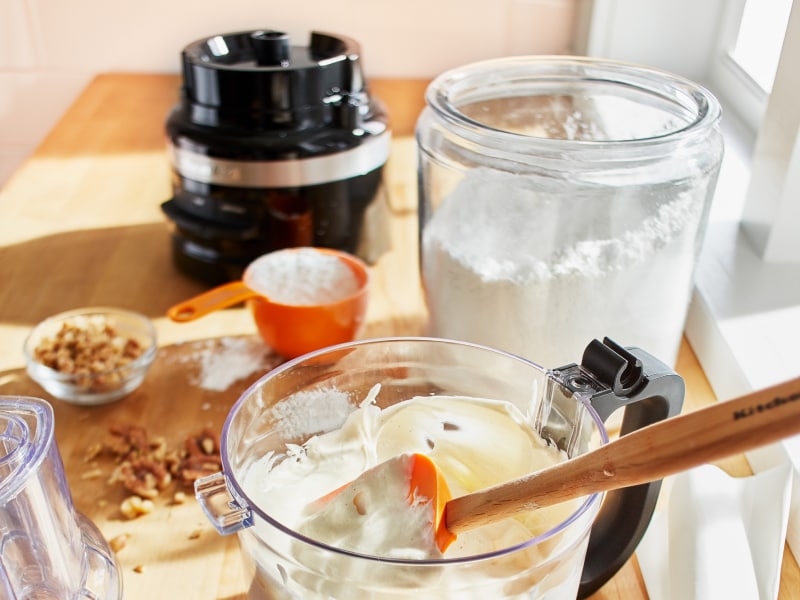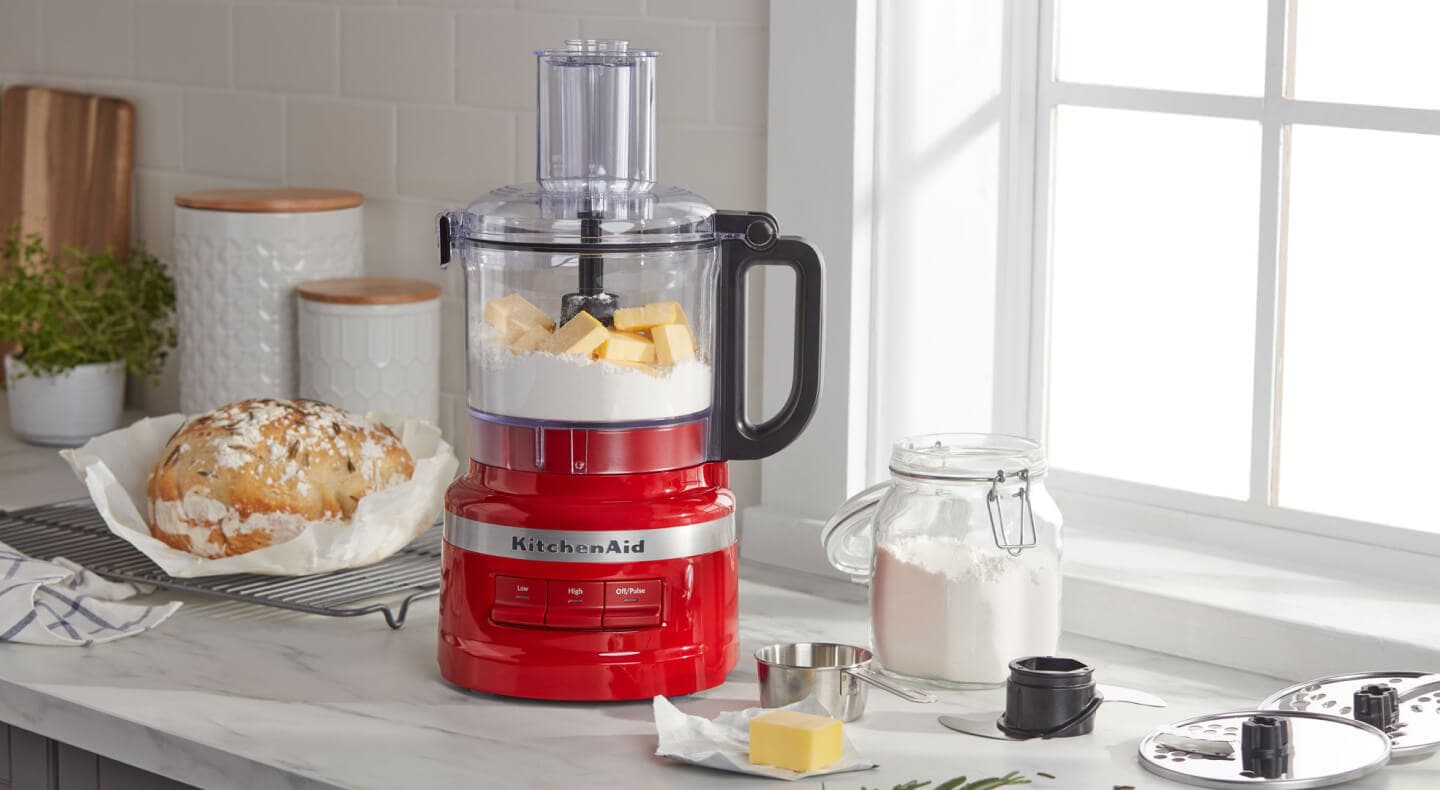
HOW TO MAKE CAKE POPS IN A FOOD PROCESSOR
A little cake, every now and then, never hurt anyone. Homemade cake pops are sweet, festive truffle bites that come together easily with a KitchenAid® food processor and a handful of ingredients. Start with a homemade cake in your favorite flavor, leftover cake—or even a cake fail—to create fun and whimsical treats for your next celebration or to brighten an ordinary day.
CAN YOU MAKE CAKE POPS IN A FOOD PROCESSOR?
Think of a cake pop as a cake lollipop. The basis of cake pops is crumbled cake mixed with frosting, which is optimally made in a food processor. Once the mixture is created, it can be formed into uniform cake balls, which are then pierced with a lollipop stick, coated and decorated.
FOOD PROCESSOR CAKE POP RECIPE
You can use any flavor of cake you like for making cake pops. Carrot, vanilla, chocolate, red velvet and pumpkin are just a few of the types of cake that make delicious cake pops. Start this easy cake pop recipe with a classic KitchenAid® stand mixer white cake a day in advance. The cake recipe is simple to customize by adding different extracts, flavorings and spices, or ingredients like chocolate chips, coconut flakes and nuts.
YIELDS
- 40 cake pops
INGREDIENTS
9x13 cake (for best results bake 1 day ahead)
Your favorite frosting
Chocolate wafers, chocolate bars, white chocolate or candy melts
Optional decorations: sprinkles, dragées, nonpareils, colored sugars, crushed cookies, crushed nuts, coconut flakes, gold leaf, icing (for piping)
COOK TIME
10 minutes
TOTAL TIME
2-3 hours and 15 minutes
TOOLS
KitchenAid® stand mixer (for cake)
Mixing bowl
Ice cream scoop
40 lollipop sticks
Foam board for drying pops
Toothpicks
- Double boiler or chocolate melting pot
PREP TIME
30 minutes to assemble cake balls
1-2 hours to chill (1 in the freezer, 2 in the fridge)
45 minutes to dip and decorate


STEP 1:
Add the completely cooled cake in chunks to the bowl of a food processor and process until the cake resembles breadcrumbs.
STEP 2:
Add frosting to the food processor and process until the mixture is almost dough-like and forms a ball. Getting the right balance of frosting to cake is important. Too little frosting and your cake balls won’t hold together well. Too much frosting and your cake balls will become too wet and heavy for the lollipop stick. Err on the side of too little at first, you can always add more to achieve the right balance.
STEP 3:
Use a small ice cream scoop or tablespoon to scoop the mixture. Roll into 1-inch balls and place on a parchment-lined baking sheet.


STEP 4:
Chill the cake balls in the fridge for two hours or in the freezer for an hour.
STEP 5:
Gently melt the chocolate in a double boiler—on a simmer burner—or melt in 30-second intervals (mixing in between) in the microwave.
STEP 6:
Re-roll the chilled balls to make sure they’re consistently round and smooth. Dip the lollipop sticks in the melted chocolate and pierce the cake balls with the sticks. Let the chocolate harden around the sticks for a minute or two, then dip the balls in chocolate to coat and gently tap off any excess. Remove any air bubbles with a toothpick to help create a seamless surface.
STEP 7:
Decorate the cake pops before the coating hardens, then place decorated cake pops in a styrofoam block to set completely before serving. You can also gently lay them on wax paper to set, just note this will give your cake pops a flat base. They won’t be perfectly round, but they will be just as delicious!
TIPS FOR MAKING CAKE BALLS AND POPS
Follow these simple tips to create consistently crave-worthy and beautiful cake pops:
Be careful not to overheat the chocolate when melting as this could cause it to harden. If your melted chocolate is too thick, add a half teaspoon of shortening or oil at a time to help get it to a good dipping consistency.
The finer the cake crumbs, the easier it will be to form the mixture into smooth, round spheres.
If you don’t have a styrofoam block, try sticking cake pops into an inverted colander to set. Or you can place them ball-side down on a parchment-lined tray to dry. They will have a flat top but this can make them easier to transport.
Add to the whimsy by using candy sticks instead of lollipop sticks to hold your cake pops. Or create a fun, more personalized look by covering your lollipop sticks or wooden skewers with decorative paper straws.
- If you want to serve your treats as cake balls, instead of cake pops, use a toothpick or fork to dip them in chocolate and serve on a pretty platter.
HOW DO YOU MAKE VEGAN CAKE POPS?
To make vegan cake pops, simply substitute the eggs and dairy in the cake and the frosting with vegan baking substitutes. Use ingredients like plant-based butters and nut-based milks instead of regular cow’s milk and butter. Replace eggs or sour cream with silken tofu, puréed apples or bananas for vegan baking. This Damp Lemon Almond Cake uses almond flour and applesauce to make a tasty, tender cake, finish with vegan frosting for vegan and gluten-free cake pops. Use your KitchenAid® blender to quickly whip up the batter for this delectable cake.
HOW DO YOU MAKE CAKE POP ICING?
The balls for cake pops are typically made with buttercream frosting or cream cheese frosting. These thick and fluffy frostings are both made with butter, confectioner’s sugar—and in the case of cream cheese frosting—cream cheese. Icing is commonly made with confectioner’s sugar and cream or milk. It’s thin, glossy and optimal for decorative piping on coated cake pops. Learn about the differences between frosting, icing and glaze.
The frosting presents a great opportunity to add your personal twist to the flavor of cake pops. Add your favorite spices or flavorings like puréed or dehydrated fruit, grated citrus or special extracts to bring your unique spin to buttercream. Try this rich Espresso Buttercream with chocolate cake for a chocolate lover’s dream cake pop. Instead of traditional cream cheese frosting, whip up this creamy Mascarpone Buttercream Frosting for a winning twist on a red velvet cake pop.
WHY ARE MY CAKE POPS CRACKING?
The most common reason for cake pops cracking is due to sudden changes in temperature. When the cold pops hit the hot chocolate the cake can expand and cracking can occur. You might find that refrigerating rather than freezing cake balls helps minimize cracking. Also, letting your cake sit out for a few minutes after chilling and allowing your chocolate or melting candies to cool for a few minutes before dipping your cake balls can help.
The chocolate needs to be warm enough and thin enough to coat the balls smoothly and easily. The cake ball mixture needs to be cool enough so the pop holds together, but not so cool that it cracks. Finding this balance may take some experimenting.
You can repair cracks by dipping a toothpick in the melted chocolate, filling the crack with it and smoothing the crack out with your finger. You can also try redipping the cracked cake pops or covering the cracks with sprinkles, icing or other decorations.
HOW CAN YOU PACKAGE AND SERVE CAKE POPS AND BALLS?
Cake pops can be the too-pretty-to-eat darling of the dessert table for a variety of parties and celebrations. Gather them in cake pop bouquets and present them in clear glass vases or mason jars filled with candies for stabilization. Cover a styrofoam block with wrapping paper and ribbons to resemble a gift, insert the pops in the block and include them on a dessert buffet. If you’re serving cake balls, or you’ve made your pops with a flat base, you can always serve them on a pretty tray or cake stand.
Cake pops also make fun food gifts. Wrap them individually or in groups of several pops in clear bags tied with ribbons and share with friends, new neighbors or anyone who deserves a treat or could use a lift.
HOW DO YOU STORE CAKE POPS?
Decorated pops can be stored in airtight containers at room temp for a week, in the fridge for 2-4 weeks and in the freezer for a month. If you’re storing at room temperature, store in a cool, dry place in a single layer and place a paper towel under and above the pops to help absorb moisture. You can store naked—or undipped pops—in airtight containers in the fridge for up to a week or in the freezer for up to a month. Thaw frozen pops in the fridge before dipping.
Cake pops taste delicious at room temperature. Make them a few days in advance and store them in the fridge. Remove 30 minutes before serving for delicious results.
If your pops contain perishable ingredients—creams, fruits, cheeses—they can’t be stored at room temp. They need to be stored in the fridge in an airtight container before serving.
EXPLORE KITCHENAID® FOOD PROCESSORS AND STAND MIXERS
Not only will KitchenAid® food processors make light work of cake pops and other desserts, they expand meal-making possibilities by adding the ability to chop, shred, mince, slice, knead, whip, mix and purée to your kitchen toolkit. Pair your food processor or chopper with the iconic KitchenAid® stand mixer, the #1 Mixer Brand in the World,1 for a powerful and stylish countertop duo.
1. Source: Euromonitor International Ltd. for retail sales revenue, USD, all retail channels. More information, including data ranges available at: mixerclaim.kitchenaid.com.






